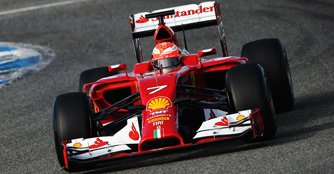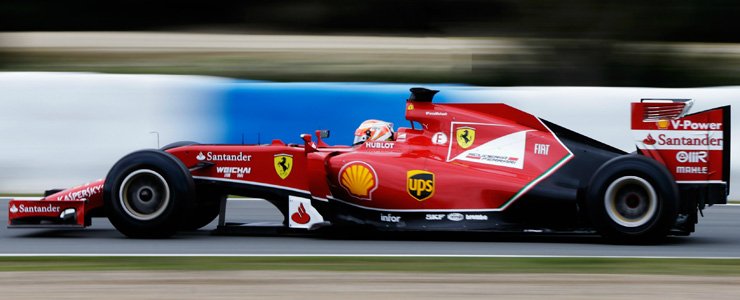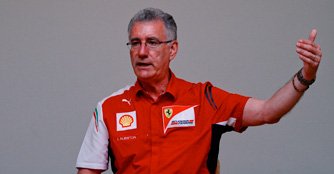Shell's bespoke trackside laboratory is an important asset to Ferrari
10 Apr 2014|7,807 views
Shell V-Power is a premium, highly celebrated, automobile fuel that promises more engine responsiveness and power through a cleaner and smoother engine. Although the benefits may sound unbelievable to the average consumer - V-Power was originally formulated for a more demanding and competitive environment - Formula One.

Shell first began working with Enzo Ferrari - founder of the Italian marque - in 1929. And in 1947, when Ferrari started building its own cars, the two firms began a world-class partnership.
Shell's F1 project team continues to grow with more than 50 Shell technical staff contributing to the Shell F1 programme. These team members work together in Shell laboratories and facilities around the world, at all the race tracks on the Grand Prix calendar, and in Maranello.
One such member is Ian Albiston - Shell's Trackside and Logistics Manager - and part of Shell's Formula One team.
Ian has a critical responsibility of ensuring all the right Shell products including petrol (all 1,400 litres of it), engine oil as well as other lubricants and fluids - along with the purpose built Shell Trackside Laboratory - are delivered to the respective circuits ahead of a race weekend.
The purpose built trackside lab is located within the Ferrari garage and has visited every Grand Prix for the past 14 years. Over a race weekend, no more than four Shell scientists based in the Trackside Laboratory have a critical task of monitoring and constantly checking the quality of the fuels to ensure compliance with highly stringent regulations set by the Federation Internationale de l'Automobile (FIA).

In the lab, more than 70 tests are conducted - to ensure the drivers get peak performance at all times along with the assurance that the fuels are fully compliant with the highly stringent rules and regulations set by the FIA and that the propellants are not contaminated.
Shell's lubricant analysis in the lab is a valuable addition to Ferrari's trackside activity, offering instantaneous information to help the team understand the condition of its engines.
For example, the lab possesses a Rotating Disc Electrode (RDE) oil analyser - a sophisticated instrument which detects an increased concentration of wear metals in the oil, and warns the team if there is excessive wear that needs to be addressed.
As the season progresses, more tests and formulations are tested, to craft the best-performing race fuels and lubricants for the team. Formula One has some of the tightest regulations on fuel composition as the chemical and physical parameters are prescribed by the FIA. The objective is to craft racing fuels relevant to fuels used for commercial purposes.
Once developed, a fuel is rigorously tested by both Shell and Ferrari and submitted to the FIA for approval. If the fuel sample by the FIA - taken anytime during a race weekend - does not match with the pre-approved fuel profile, the team can be disqualified. Shell not only develops the fuel and lubricants for the Ferrari team, but also provides the racing team with a full analytical service at every race.
 |
The changes Formula One faces in the 2014 season are deemed to be the most comprehensive the sport has experienced since its inception in the 1950s - with an increased focus on increasing energy efficiency and energy recovery.

In addition, fuel load has been reduced from 130 litres in 2013 to 100 litres in 2014 - along with a new regulation that requires teams to run only five power units in 2014 - in comparison to eight units last year.
This highly stresses the durability and reliability factor of the all new power units as each unit has to withstand 4,000km of mileage in contrast to just 2,500km last year.
These highly efficient power units, combined with around a 30 percent reduction in fuel payload, have presented Shell scientists with the demanding task of formulating a race fuel that delivers the right balance between maximum power, performance and energy efficiency.
The challenge began over three years ago and since, Shell has worked alongside Ferrari, supplying over 50 candidate formulations for intensive evaluation and testing in Maranello in the quest to find the optimum performance. After years of hard work and several sleepless nights by the crew of both Shell and Ferrari - the Ferrari F14 T is claimed to be the most efficient Scuderia Ferrari single seater ever built - thanks in part to the new 2014 race fuels, combined with the powerful ERS unit.
The difficulties that Shell and Ferrari faced in preparation for the 2014 season are highlighted in the short documentary - Horse Power. The documentary - which had its Asian Premiere during our visit to Putrajaya, Malaysia, late last week, showcases Ferrari's preparation for the new regulation changes and the difficulties the team and Shell faced in producing this year's contender.
With a running time of almost 28 minutes, the documentary can, for some, be considered long. But if you are a fan of the sport or the team, every minute is worth watching.
Shell V-Power is a premium, highly celebrated, automobile fuel that promises more engine responsiveness and power through a cleaner and smoother engine. Although the benefits may sound unbelievable to the average consumer - V-Power was originally formulated for a more demanding and competitive environment - Formula One.

Shell first began working with Enzo Ferrari - founder of the Italian marque - in 1929. And in 1947, when Ferrari started building its own cars, the two firms began a world-class partnership.
Shell's F1 project team continues to grow with more than 50 Shell technical staff contributing to the Shell F1 programme. These team members work together in Shell laboratories and facilities around the world, at all the race tracks on the Grand Prix calendar, and in Maranello.
One such member is Ian Albiston - Shell's Trackside and Logistics Manager - and part of Shell's Formula One team.
Ian has a critical responsibility of ensuring all the right Shell products including petrol (all 1,400 litres of it), engine oil as well as other lubricants and fluids - along with the purpose built Shell Trackside Laboratory - are delivered to the respective circuits ahead of a race weekend.
The purpose built trackside lab is located within the Ferrari garage and has visited every Grand Prix for the past 14 years. Over a race weekend, no more than four Shell scientists based in the Trackside Laboratory have a critical task of monitoring and constantly checking the quality of the fuels to ensure compliance with highly stringent regulations set by the Federation Internationale de l'Automobile (FIA).

In the lab, more than 70 tests are conducted - to ensure the drivers get peak performance at all times along with the assurance that the fuels are fully compliant with the highly stringent rules and regulations set by the FIA and that the propellants are not contaminated.
Shell's lubricant analysis in the lab is a valuable addition to Ferrari's trackside activity, offering instantaneous information to help the team understand the condition of its engines.
For example, the lab possesses a Rotating Disc Electrode (RDE) oil analyser - a sophisticated instrument which detects an increased concentration of wear metals in the oil, and warns the team if there is excessive wear that needs to be addressed.
As the season progresses, more tests and formulations are tested, to craft the best-performing race fuels and lubricants for the team. Formula One has some of the tightest regulations on fuel composition as the chemical and physical parameters are prescribed by the FIA. The objective is to craft racing fuels relevant to fuels used for commercial purposes.
Once developed, a fuel is rigorously tested by both Shell and Ferrari and submitted to the FIA for approval. If the fuel sample by the FIA - taken anytime during a race weekend - does not match with the pre-approved fuel profile, the team can be disqualified. Shell not only develops the fuel and lubricants for the Ferrari team, but also provides the racing team with a full analytical service at every race.The changes Formula One faces in the 2014 season are deemed to be the most comprehensive the sport has experienced since its inception in the 1950s - with an increased focus on increasing energy efficiency and energy recovery.

In addition, fuel load has been reduced from 130 litres in 2013 to 100 litres in 2014 - along with a new regulation that requires teams to run only five power units in 2014 - in comparison to eight units last year.
This highly stresses the durability and reliability factor of the all new power units as each unit has to withstand 4,000km of mileage in contrast to just 2,500km last year.
These highly efficient power units, combined with around a 30 percent reduction in fuel payload, have presented Shell scientists with the demanding task of formulating a race fuel that delivers the right balance between maximum power, performance and energy efficiency.
The challenge began over three years ago and since, Shell has worked alongside Ferrari, supplying over 50 candidate formulations for intensive evaluation and testing in Maranello in the quest to find the optimum performance. After years of hard work and several sleepless nights by the crew of both Shell and Ferrari - the Ferrari F14 T is claimed to be the most efficient Scuderia Ferrari single seater ever built - thanks in part to the new 2014 race fuels, combined with the powerful ERS unit.
The difficulties that Shell and Ferrari faced in preparation for the 2014 season are highlighted in the short documentary - Horse Power. The documentary - which had its Asian Premiere during our visit to Putrajaya, Malaysia, late last week, showcases Ferrari's preparation for the new regulation changes and the difficulties the team and Shell faced in producing this year's contender.
With a running time of almost 28 minutes, the documentary can, for some, be considered long. But if you are a fan of the sport or the team, every minute is worth watching.
Thank You For Your Subscription.























